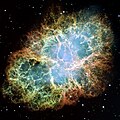Dosya:Crab Nebula.jpg
Appearance

Vervênayışê ebadê: 600 × 600 piksel. Agoznayışê bini: 240 × 240 piksel | 480 × 480 piksel | 768 × 768 piksel | 1,024 × 1,024 piksel | 2,048 × 2,048 piksel | 3,864 × 3,864 piksel.
Ebato oricinale (3,864 × 3,864 pikselan, ebatê dosya: 13.84 MB, MIME tipê cı: image/jpeg)
Verêniya dosya
Seba diyayışê viyarteyê dosya ra tarixê ke qısımê tarix/zemani derê inan bıtıkne.
| Tarix/Zeman | Resımo qıckek | Ebadi | Karber | Mışewre | |
|---|---|---|---|---|---|
| nıkayên | 14:56, 25 Tışrino Peyên 2012 |  | 3,864 - 3,864 (13.84 MB) | Hawky.diddiz | Lossless optimization |
| 10:13, 17 Gulane 2012 |  | 3,864 - 3,864 (14.61 MB) | Metrónomo | Higher quality | |
| 09:31, 20 Hezirane 2009 |  | 3,864 - 3,864 (6.18 MB) | Tryphon | Higher resolution. | |
| 21:26, 9 Adare 2006 |  | 2,224 - 2,212 (3.08 MB) | Stianbh | larger version | |
| 00:35, 16 Çele 2006 |  | 400 - 400 (23 KB) | DragonFire1024 | Image: A New View of the Helix Nebula Source: http://hubblesite.org/gallery/album/entire_collection/pr2004032d/ Copyright Notice: Material credited to STScI on this site was created, authored, and/or prepared for NASA under Contract NAS5-26555. Unless |
Gurenayışê dosya
100 ra zêde peli na dosya gurenenê. Ena lista cêrêne dosyeyanê 100 sıfteyınanê ke tenya na dosya gurenenê, inan mocnena. Yew lista pêro mevcuda.
- Fizikê Asmêni
- NGC 1
- NGC 10
- NGC 101
- NGC 102
- NGC 11
- NGC 12
- NGC 126
- NGC 127
- NGC 13
- NGC 14
- NGC 15
- NGC 152
- NGC 16
- NGC 17
- NGC 177
- NGC 18
- NGC 19
- NGC 2
- NGC 202
- NGC 203
- NGC 21
- NGC 22
- NGC 227
- NGC 23
- NGC 2308
- NGC 24
- NGC 25
- NGC 250
- NGC 252
- NGC 2594
- NGC 26
- NGC 27
- NGC 277
- NGC 28
- NGC 2809
- NGC 2947
- NGC 3
- NGC 30
- NGC 3018
- NGC 302
- NGC 31
- NGC 32
- NGC 327
- NGC 33
- NGC 35
- NGC 352
- NGC 36
- NGC 37
- NGC 377
- NGC 38
- NGC 39
- NGC 4
- NGC 40
- NGC 402
- NGC 41
- NGC 42
- NGC 427
- NGC 43
- NGC 44
- NGC 45
- NGC 46
- NGC 47
- NGC 48
- NGC 49
- NGC 5
- NGC 50
- NGC 51
- NGC 52
- NGC 53
- NGC 54
- NGC 55
- NGC 56
- NGC 57
- NGC 59
- NGC 6
- NGC 60
- NGC 61
- NGC 62
- NGC 63
- NGC 64
- NGC 65
- NGC 66
- NGC 67
- NGC 68
- NGC 69
- NGC 7
- NGC 70
- NGC 71
- NGC 72
- NGC 73
- NGC 74
- NGC 75
- NGC 76
- NGC 77
- NGC 7837
- NGC 7838
- NGC 7839
- NGC 7840
- NGC 8
Tayêna gıreyanê na pele bıvênên.
Gurenayışê dosyaya gılovere
Ena dosya wikiyanê binan de gureniyena.
- af.wikipedia.org sero guriyayış
- 1054
- Wikipedia:Uitgesoekte herdenkings/22 April
- Wikipedia:Uitgesoekte herdenkings/Julie
- Wikipedia:Uitgesoekte herdenkings/April
- Wikipedia:Uitgesoekte herdenkings/4 Julie
- Supernova
- Ster
- Wikipedia:Beeld van die week/2012
- Wikipedia:Voorbladbeeld week 2 2012
- Newel
- Kompakte ster
- Veranderlike ster
- Lys van Messier-voorwerpe
- Krapnewel
- Portaal:Sterrekunde/Inleiding
- Portaal:Sterrekunde
- Hemelliggaam
- Lys van planetêre newels
- SN 1054
- Supernova-oorblyfsel
- Sterevolusie
- als.wikipedia.org sero guriyayış
- am.wikipedia.org sero guriyayış
- anp.wikipedia.org sero guriyayış
- ar.wikipedia.org sero guriyayış
- مجرة
- نجم
- سنة
- تطور النجوم
- ثلاثي الكربون
- فجر
- مستعر أعظم
- بوابة:علم الفلك/مقالة مختارة
- شهاب
- مطلع مستقيم
- جمعية منسا الدولية
- علم الفلك خارج المجري
- عنقود نجمي
- فيلا (أقمار اصطناعية)
- الشلياق
- خرزات بيلي
- راية الأرض
- سمت
- نظرية الحالة الثابتة
- توهج القمر الصناعي
- بوابة:الفيزياء/بوابات ذات علاقة
- بوابة:الفضاء
- الظهر
- اقتران (علم الفلك)
- علم الهيئة
Yê na dosya gurenayışê gıloveri tayêna bıvêne.
